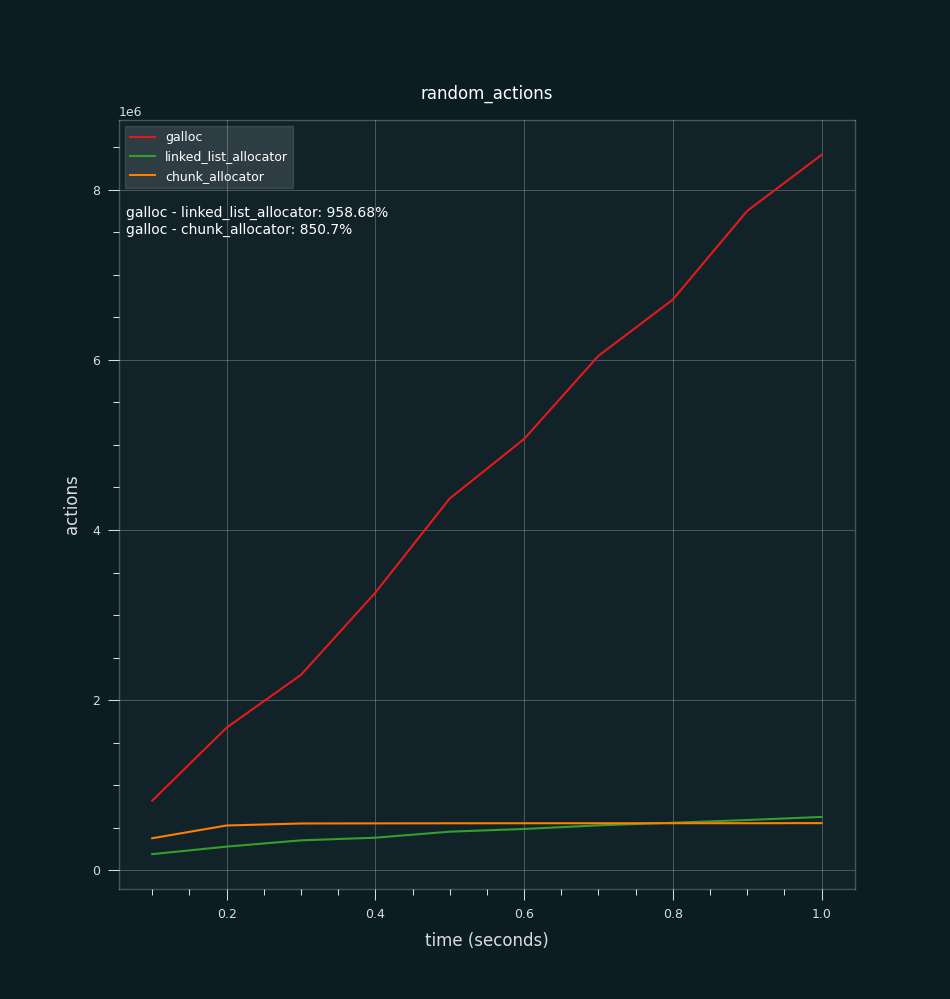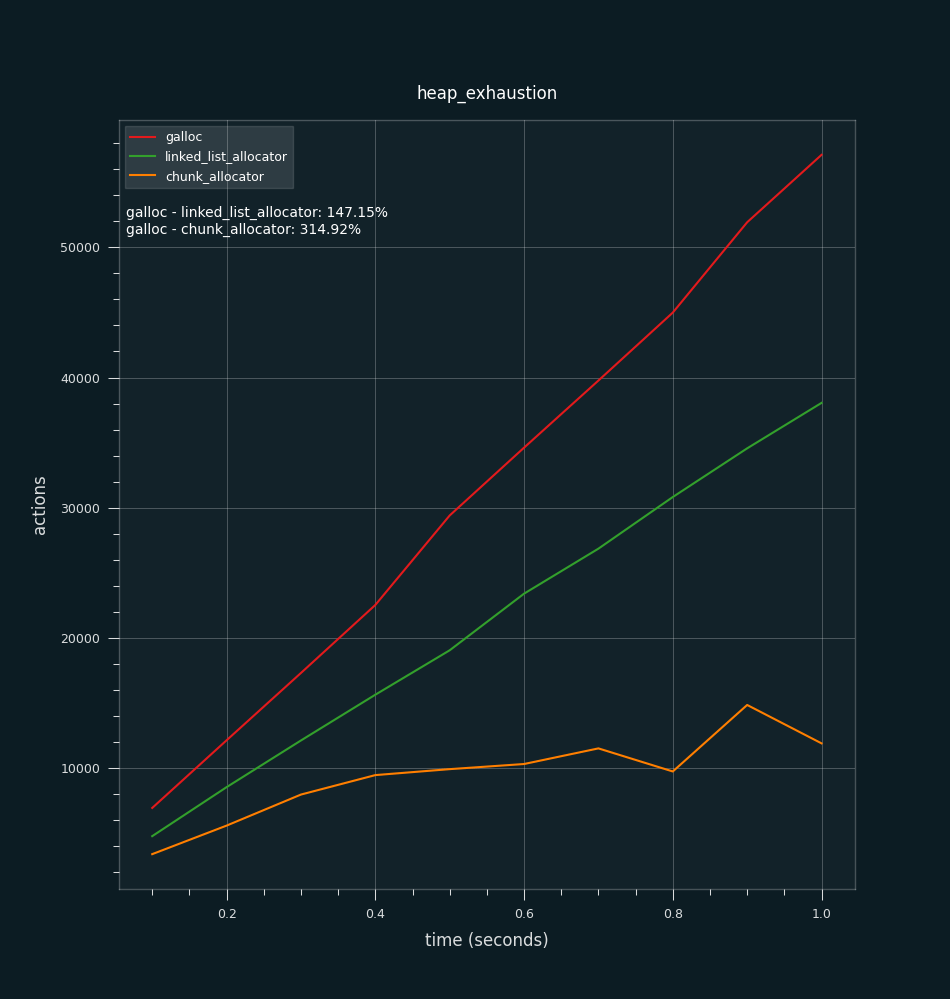8 releases
| 0.1.7 | Nov 9, 2022 |
|---|---|
| 0.1.6 | Oct 21, 2022 |
#148 in Memory management
2,415 downloads per month
Used in 2 crates
150KB
2K
SLoC
galloc - good_memory_allocator
This is a linked list allocator, inspired by the dlmalloc algorithm, to be used in no_std environments such as operating system kernels.
The overhead for each allocation is a single usize.
The implementation prioritizes runtime efficiency over memory efficiency, but also provides very good memory utilization.
The allocator is heavily tested with test cases covering almost all code paths; fuzzing is used to cover the rest.
Usage
Create a static allocator:
use good_memory_allocator::SpinLockedAllocator;
#[global_allocator]
static ALLOCATOR: SpinLockedAllocator = SpinLockedAllocator::empty();
Before using this allocator, you need to initialize it:
pub fn init_heap() {
unsafe {
ALLOCATOR.init(heap_start, heap_size);
}
}
SMALLBINS_AMOUNT and ALIGNMENT_SUB_BINS_AMOUNT.
The allocator allows configuring the amount of smallbins and alignment
sub-bins that it uses. For those of you not familiar with smallbins, they
are data structures used by the allocator to keep track of free chunks. Each
smallbin is made up of multiple alignment sub-bins. The default amounts of
smallbins and alignment sub-bins used by the allocator are stored in their
respective constant DEFAULT_SMALLBINS_AMOUNT and
DEFAULT_ALIGNMENT_SUB_BINS_AMOUNT.
Increasing the amount of smallbins will improve runtime performance and
memory utilization, especially when you are making a lot of relatively small
allocation, but it will also increase the size of the Allocator struct.
Increasing the amount of alignment sub-bins will will also improve runtime
performance and memory utilization, especially when you are making a lot of
allocations with relatively large alignments, but it will also increase the
size of the Allocator struct.
It is recommended to choose a value that is a power of 2 for the alignemnt
sub-bins amount, since that will improve the memory utilization of the
smallbins' memory.
The amount of alignment sub bins must be at least 2, otherwise you will get a compilation error.
If you are in a memory constrained environment, you might want to use lower
values for these constants, since the size of the Allocator struct using
the default values is relatively large.
Features
spin(default): Provide aSpinLockedAllocatortype that implements theGlobalAlloctrait by using a spinlock.allocator: Provides an implementation of the unstableAllocatortrait for theSpinLockedAllocatortype.
Performance
In most cases, allocation is O(1), mostly for relatively small allocations with relatively small alignment.
Deallocation is always O(1).
Reallocaiton uses a custom algorithm which tries to prevent copying of memory as much as possible, by reallocating in place.
The overall performance of the allocator is superb, and it performs better than all other alternative allocators which we could find on crates.io.
Benchmarks
We benchmarked galloc using multiple benchmarks against 2 other crates that we found on crates.io, that seem to provide similar functionality: simple-chunk-allocator and linked-list-allocator.
In each benchmark, each allocator is given a certain duration and must perform as many operations as it can in the given duration.
Random Actions
The first benchmark that we used is called random_actions.
In this benchmark each allocator tries to perform as many allocations, deallocations and reallocations as it can in the given duration.
The size and alignment of the allocations and reallocations is random.
In each iteration, the benchmark randomly chooses between allocation, deallcation and reallocation.

In the top left, below the legend, you can see the percentage difference of the number of actions between galloc and each of the other allocators.
The percentage difference is calculated using the following formula: a / b * 100, where a is galloc's score, and b is the other allocator's score.
You can see that galloc outperforms both other allocators by almost an order of magnitude.
Heap Exhaustion
The second benchmark that we used is called heap_exhaustion.
In this benchmark each allocator performs as many allocations as it can in the given duration.
The size and alignment of the allocations is random.
Once an allocation request fails, it means that the heap was exhausted, and the allocator's score is punished by making it sleep for a certain duration.
Thus, this benchmark measures how well the allocator utilizes its memory, since all allocators are given a heap of the same size.

Here, too, galloc outperforms the 2 other allocators.
Simple Chunk Allocator Benchmarks
The simple-chunk-allocator crate provides a benchmark of its own.
Here is an explanation of the benchmark from simple-chunk-allocator's readme:
The benchmark performs random allocations of different sizes and alignments and also deallocates some of the older allocations. Over time, the heap becomes full, which is why the number of successful allocations has a higher delta to the attempted allocations.
We ran these benchmarks on the 3 allocators including galloc, and the results were as follows:
Duration: 1 second
RESULTS OF BENCHMARK: Chunk Allocator
51244 allocations, 15404 successful_allocations, 35840 deallocations
median= 1210 ticks, average= 1232 ticks, min= 218 ticks, max=144410 ticks
RESULTS OF BENCHMARK: Linked List Allocator
34937 allocations, 10829 successful_allocations, 24108 deallocations
median= 28778 ticks, average= 41553 ticks, min= 78 ticks, max=1165606 ticks
RESULTS OF BENCHMARK: Galloc
51694 allocations, 15651 successful_allocations, 36043 deallocations
median= 176 ticks, average= 654 ticks, min= 90 ticks, max=989542 ticks
Duration: 10 seconds
RESULTS OF BENCHMARK: Chunk Allocator
79818 allocations, 23909 successful_allocations, 55909 deallocations
median= 1294 ticks, average=320782 ticks, min= 174 ticks, max=13773388 ticks
RESULTS OF BENCHMARK: Linked List Allocator
113181 allocations, 30521 successful_allocations, 79611 deallocations
median= 91688 ticks, average=120273 ticks, min= 80 ticks, max=1831252 ticks
RESULTS OF BENCHMARK: Galloc
147720 allocations, 32754 successful_allocations, 103313 deallocations
median= 214 ticks, average= 39177 ticks, min= 88 ticks, max=2228776 ticks
As you can see, galloc outperformed both of them in both test cases. This is especially noticable in the 10 seconds test.